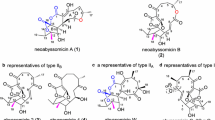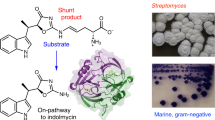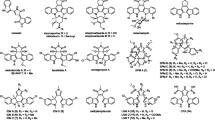Abstract
The deep-sea-derived microbe Streptomyces scopuliridis SCSIO ZJ46 produces desotamides A–D. Notably, desotamides A and B display antibacterial activities against pathogenic Gram-positive Streptococcus pneumoniae NCTC 7466, Staphylococcus aureus ATCC 29213, and the methicillin-resistant clinical isolate Staphylococcus epidermidis (MRSE) shhs-E1. The 39-kb desotamide biosynthetic gene cluster (dsa) has previously been identified and heterologously expressed in S. coelicolor M1152 for the purposes of assigning dsa gene functions. In this work, we identified seven genes in the dsa cluster including three regulatory genes (dsaA, dsaM, and dsaN), two transporter genes (dsaK and dsaL), and two other genes, dsaB (annotated as a phosphate synthase) and dsaJ (a PBP-type thioesterase). The DsaA and DsaN were unambiguously shown to be positive regulators of desotamide biosynthesis, and consistent with these roles, inactivation of either gene completely abolished desotamide production. Moreover, overexpression of dsaA or dsaN (independent of each other) was shown to improve desotamide titers. Production of desotamides in M1152/07-6H::dsaA strain was 2.4-fold greater than that in the heterologous dsa expression strain M1152/07-6H whereas desotamide titers from the M1152/07-6H::dsaN strain were about twice that of M1152/07-6H. In addition, inactivation of dsaB and dsaJ (independent of each other) completely abolished desotamide production, indicating their indispensability for desotamide assembly. These studies provide new insights into the functions and combinatorial biosynthetic potentials of seven key genes within the dsa biosynthetic gene cluster. Findings reported here are likely to facilitate further efforts aimed at assessing and developing the desotamides and related analogs for future applications.



Similar content being viewed by others
References
Arias CA, Murray BE (2009) Antibiotic-resistant bugs in the 21st century — a clinical super-challenge. New Engl J Med 360(5):439–443. https://doi.org/10.1056/NEJMp0804651
Bagautdinov B, Yutani K (2011) Structure of indole-3-glycerol phosphate synthase from Thermus thermophilus HB8: implications for thermal stability. Acta Crystallogr D 67(12):1054–1064. https://doi.org/10.1107/S0907444911045264
Bogaert D, de Groot R, Hermans PWM (2004) Streptococcus pneumoniae colonisation: the key to pneumococcal disease. Lancet Infect Dis 4(3):144–154. https://doi.org/10.1016/S1473-3099(04)00938-7
Boucher HW, Talbot GH, Bradley JS, Edwards JE, Gilbert D, Rice LB, Scheld M, Spellberg B, Bartlett J (2009) Bad bugs, no drugs: no ESKAPE! An update from the infectious diseases society of America. Clin Infect Dis 48(1):1–12. https://doi.org/10.1086/595011
Busenlehner LS, Pennella MA, Giedroc DP (2003) The SmtB/ArsR family of metalloregulatory transcriptional repressors: structural insights into prokaryotic metal resistance. FEMS Microbiol Rev 27(2–3):131–143. https://doi.org/10.1016/S0168-6445(03)00054-8
Creighton TE, Yanofsky C (1966) Indole-3-glycerol phosphate synthetase of Escherichia coli, an enzyme of the tryptophan operon. J Biol Chem 241(20):4616–4624
Doumith M, Weingarten P, Wehmeier UF, Salah-Bey K, Benhamou B, Capdevila C, Michel JM, Piepersberg W, Raynal MC (2000) Analysis of genes involved in 6-deoxyhexose biosynthesis and transfer in Saccharopolyspora erythraea. Mol Gen Genet 264:477–485. https://doi.org/10.1007/s004380000329
Fu J, Qin R, Zong G, Zhong C, Zhang P, Kang N, Qi X, Cao G (2019) The two-component system CepRS regulates the cephamycin C biosynthesis in Streptomyces clavuligerus F613-1. AMB Express 9(1):118. https://doi.org/10.1186/s13568-019-0844-z
Higgins CF (1992) ABC transporters: from microorganisms to man. Annu Rev Cell Biol 8(1):67–113. https://doi.org/10.1146/annurev.cb.08.110192.000435
Hyde SC, Emsley P, Hartshorn MJ, Mimmack MM, Gileadi U, Pearce SR, Gallagher MP, Gill DR, Hubbard RE, Higgins CF (1990) Structural model of ATP-binding proteins associated with cystic fibrosis, multidrug resistance and bacterial transport. Nature 346(6282):362–365. https://doi.org/10.1038/346362a0
Khalil ZG, Salim AA, Lacey E, Blumenthal A, Capon RJ (2014) Wollamides: antimycobacterial cyclic hexapeptides from an Australian soil Streptomyces. Org Lett 16(19):5120–5123. https://doi.org/10.1021/ol502472c
Kim JS, Kang SO, Lee JK (2003) The protein complex composed of nickel-binding SrnQ and DNA binding motif-bearing SrnR of Streptomyces griseus represses sodF transcription in the presence of nickel. J Biol Chem 278(20):18455–18463. https://doi.org/10.1074/jbc.m211740200
Knöchel T, Pappenberger A, Jansonius JN, Kirschner K (2002) The crystal structure of indoleglycerol-phosphate synthase from Thermotoga maritima. J Biol Chem 277(10):8626–8634. https://doi.org/10.1074/jbc.M109517200
Kuranaga T, Matsuda K, Sano A, Kobayashi M, Ninomiya A, Takada K, Matsunaga S, Wakimoto T (2018) Total synthesis of the nonribosomal peptide surugamide B and identification of a new offloading cyclase family. Angew Chem Int Ed 130(30):9591–9595. https://doi.org/10.1002/ange.201805541
Li Q, Song Y, Qin X, Zhang X, Sun A, Ju J (2015) Identification of the biosynthetic gene cluster for the anti-infective desotamides and production of a new analogue in a heterologous host. J Nat Prod 78(4):944–948. https://doi.org/10.1021/acs.jnatprod.5b00009
Li Q, Qin X, Liu J, Gui C, Wang B, Li J, Ju J (2016) Deciphering the biosynthetic origin of l-allo-isoleucine. J Am Chem Soc 138(1):408–415. https://doi.org/10.1021/jacs.5b11380
Mascher T, Helmann JD, Unden G (2006) Stimulus perception in bacterial signal-transducing histidine kinases. Microbiol Mol Biol R 70(4):910–938. https://doi.org/10.1128/mmbr.00020-06
Oh EA, Kim M-S, Chi W-J, Kim J-H, Hong S-K (2007) Characterization of the sgtR1 and sgtR2 genes and their role in regulating expression of the sprT gene encoding Streptomyces griseus trypsin. FEMS Microbiol Lett 276(1):75–82. https://doi.org/10.1111/j.1574-6968.2007.00907.x
Paulsen IT, Brown MH, Skurray RA (1996) Proton-dependent multidrug efflux systems. Microbiol Mol Biol Rev 60(4):575
Pratt R-F (2008) Substrate specificity of bacterial DD-peptidases (penicillin-binding proteins). Cell Mol Life Sci 65:2138–2155. https://doi.org/10.1007/s00018-008-7591-7
Qiu J, Zhuo Y, Zhu D, Zhou X, Zhang L, Bai L, Deng Z (2011) Overexpression of the ABC transporter AvtAB increases avermectin production in Streptomyces avermitilis. Appl Microbiol Biot 92(2):337–345. https://doi.org/10.1007/s00253-011-3439-4
Romero-Rodríguez A, Robledo-Casados I, Sánchez S (2015) An overview on transcriptional regulators in Streptomyces. BBA-Gene Regul Mech 1849(8):1017–1039. https://doi.org/10.1016/j.bbagrm.2015.06.007
Son S, Hong Y-S, Jang M, Heo KT, Lee B, Jang J-P, Kim J-W, Ryoo I-J, Kim W-G, Ko S-K, Kim BY, Jang J-H, Ahn JS (2017) Genomics-driven discovery of chlorinated cyclic hexapeptides ulleungmycins A and B from a Streptomyces species. J Nat Prod 80(11):3025–3031. https://doi.org/10.1021/acs.jnatprod.7b00660
Song Y, Li Q, Liu X, Chen Y, Zhang Y, Sun A, Zhang W, Zhang J, Ju J (2014) Cyclic hexapeptides from the deep South China Sea-derived Streptomyces scopuliridis SCSIO ZJ46 active against pathogenic gram-positive bacteria. J Nat Prod 77(8):1937–1941. https://doi.org/10.1021/np500399v
Tu J, Li S, Chen J, Song Y, Fu S, Ju J, Li Q (2018) Characterization and heterologous expression of the neoabyssomicin/abyssomicin biosynthetic gene cluster from Streptomyces koyangensis SCSIO 5802. Microb Cell Factories 17(1):28. https://doi.org/10.1186/s12934-018-0875-1
Zhang Y, Huang H, Chen Q, Luo M, Sun A, Song Y, Ma J, Ju J (2013) Identification of the grincamycin gene cluster unveils divergent roles for GcnQ in different hosts, tailoring the l-rhodinose moiety. Org Lett 15(13):3254–3257. https://doi.org/10.1021/ol401253p
Acknowledgments
We thank Dr. Changsheng Zhang (South China Sea Institute of Oceanology, Chinese Academy of Science) for kind supply of plasmid pPWW50.
Funding
This study was supported in part by the Natural Key Research and development Program of China (2017YFD0201400), the China NSF (31670087, 31400072 and U1706206), the Key Special Project for Introduced Talents Team of Southern Marine Science and Engineering Guangdong Laboratory (Guangzhou, GML2019ZD0406), the Guangdong NSF (2016A030312014), the Pearl River S&T Nova Program of Guangzhou (201806010109), the Special Support Program for Training High-Level Talents in Guangdong (No. 2016TQ03R288), and the CAS (XDA13020302-2).
Author information
Authors and Affiliations
Contributions
Qinglian Li and Jianhua Ju conceived and designed study. Wenjuan Ding and Yuliang Dong conducted experiments. Qinglian Li and Wenjuan Ding analyzed data. Wenjuan Ding, Qinglian Li, and Jianhua Ju wrote the manuscript. All authors read and approved the manuscript.
Corresponding authors
Ethics declarations
Conflict of interest
The authors declare that they have no conflict of interest.
Ethics approval
This article does not contain any studies with human participants or animals performed by any of the authors.
Additional information
Publisher’s note
Springer Nature remains neutral with regard to jurisdictional claims in published maps and institutional affiliations.
Electronic supplementary material
ESM 1
(PDF 1780 kb)
Rights and permissions
About this article
Cite this article
Ding, W., Dong, Y., Ju, J. et al. The roles of genes associated with regulation, transportation, and macrocyclization in desotamide biosynthesis in Streptomyces scopuliridis SCSIO ZJ46. Appl Microbiol Biotechnol 104, 2603–2610 (2020). https://doi.org/10.1007/s00253-020-10414-4
Received:
Revised:
Accepted:
Published:
Issue Date:
DOI: https://doi.org/10.1007/s00253-020-10414-4




